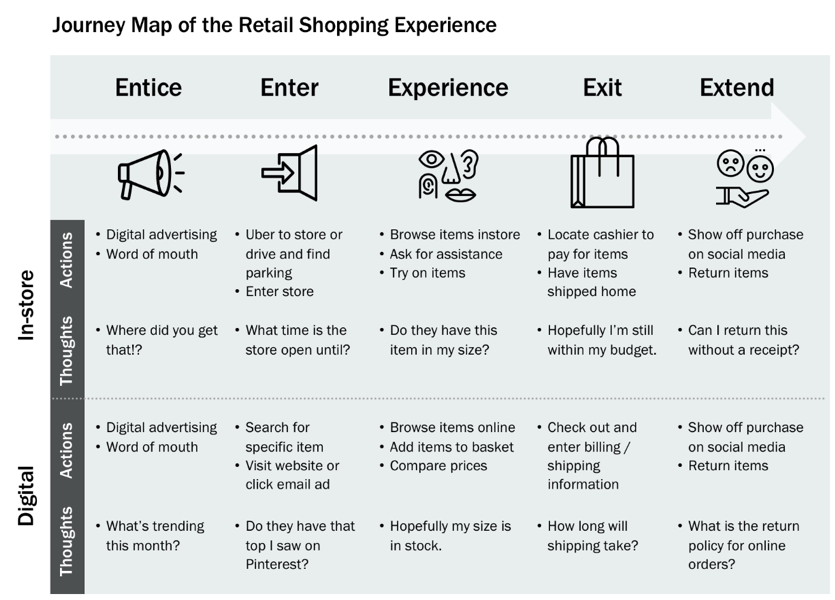The Resurgence of Retail: Focus on Customer Empathy to Refresh the In-store Shopping Experience
The retail industry has drastically transformed throughout the last several years due to a multitude of factors. Changing consumer preferences, digitalization, and the surge of E-commerce giants such as Amazon, to name a few, have reshaped the traditional shopping experience. With the combination of factors at play, retailers are challenged to efficiently adapt to or drive value with digitalization.
The Need for Speed
In the past, brick and mortar defined the paradigm of the consumer shopping experience. A traditional store visit provided consumers with the benefits of an in-store experience, interaction with products and sales associates, and immediate takeaways. Higher conversion rates and lower return rates were generally expected by retailers. While these benefits are still present today, limited in-store selection, lack of convenience for consumers, and the rise of mobile E-commerce have contributed to a major shift in the retail industry.
E-Commerce and Digitalization
As a result of brick and mortar’s failure to provide unlimited selection at the ready, E-commerce has revolutionized retail. Digitalizing retail through E-commerce has provided the consumer with a multitude of benefits which include:
- Convenience, allowing consumers to shop anywhere at anytime
- Access to a larger selection of products
- Ability to easily research and compare products across companies
- Ability to integrate mobile social communities such as Facebook, Twitter, and Instagram
- Use of mobile payment such asGoogle wallet, Apple Pay, and Square Cash
While the majority of retail sales still occur in brick and mortar locations (over 90% as indicated by 2017 U.S. Census Data1), E-commerce sales continue to grow annually, posing a large threat. So far, many brick and mortar retailers have already proven ineffective at thriving- or even surviving- with the rise in digitalization. How can brick and mortar retailers be successful? In-store retail experiences need to rebrand as a new, integrated service that provides the best customer experience. Jennifer Hyman, founder and CEO of Rent the Runway, summed up the challenge this way2:
“In order for a brand to survive, its physical presence will need to offer something distinct yet complementary to its mobile or online experience. Without a mobile-first approach, a seamless user experience across devices, and a digitally literate workforce, every day is a missed opportunity to be the disruptor, and not the disrupted.”
Understand your Customers with Design Research

Design research can be the answer to retail’s challenge. Not to be confused with apparel/fashion design or research design, design research is a customer empathy approach which seeks to understand the people affected by a given solution and supports the strategic development and refinement of products, services, and experiences. By placing customer needs first, design research provides an innovative solution to the challenges facing the retail industry. One design research practice that can be applied to the retail industry is journey mapping. Also known as experience mapping, journey mapping entails capturing and communicating complex interactions between customers and your brand. The goal of journey mapping in retail is to build knowledge and consensus across the organization while simultaneously building seamless customer experiences across all touchpoints. To truly reshape the customer shopping experience, retailers should utilize customer journey maps to identify and assess pain points shoppers experience from engaging, entering, experiencing, and exiting the store plus any interactions beyond the sale. In this process, all challenges and opportunities would be considered from the product on the shelves to the ambiance of the store. Implementing design research techniques opens the door for retailers to reinvent the store experience by designing valuable and desirable experiences for consumers that can’t be found online.
Creating a Seamless Experience
Omnichannel retail strategies that fuse digital and physical shopping experiences are gaining traction with customers and retailers. In a recent survey of 46,000 shoppers conducted by HBR, 73% were found to use multiple channels across their shopping journey.3 Compared to customers using just one channel, the research found those who used 4+ channels spent on average 9% more in the store. Beyond online stores, retailers can provide touchpoints across smartphone apps and in-store digital tools (e.g. interactive catalogs, a price-checker, or a tablet) to augment and improve the customer experience. Recognizing the need for multiple touchpoints, Canadian fashion retailer Frank and Oak continues to expand its brick and mortar footprint across the country, despite its origins as an exclusively online store. On Frank and Oak’s growth, co-founder Ethan Song states4
“The number of locations is not nearly as important as creating unique experiences for customers."
When facilitating a design research study, it’s important to capture each touchpoint across the retail experience to holistically understand how customers engage with your brand.
Where Should Retailers Start?
By holding in depth qualitative interviews with customers, retailers can elicit insights and feedback from shoppers and inform the journey map. These interviews might reveal adjacent user needs that physical stores could address with new value propositions. Once needs are identified, retailers should take an agile approach to generate new service offerings, testing these concepts out with real consumers and evaluating which experiences they might be drawn to. Furthermore, retailers could team up with consumers to co-create new hybrid spaces and renew the appeal that brick and mortar stores once had. Lego’s creation of the ambassador program serves as an example of the success of corporate/consumer collaboration. Launched in 2005, the program established a fast and direct way for the company and its fans to get into contact with one another. For Lego, the program offered exposure to new ideas, new technologies and new business partnerships. For consumers, collaborating with Lego allowed them to influence business decisions and encourage the company to develop products targeting teens and adults. Through this program, Lego has been able to develop a solid understanding of what it takes to build and maintain profitable and mutually beneficial collaboration with users. In the future, other organizations can look to benefit from the inclusion of consumers.
Retailers should follow these five critical steps for successfully mapping and evaluating the customer experience:
- Uncover the truth – Study customer behavior and interactions across channels and touchpoints
- Chart the course – Collaboratively synthesize key insights into a customer journey model
- Tell the story – Visualize a compelling story that creates empathy and understanding
- Use the Map – Follow the map to new ideas and better customer experiences
- Repeat – Refresh the map to ensure customer experiences are continuously improved
What Does the Future Hold for Design Research?
While face-to-face research allows retailers to identify and evaluate customer needs quickly and locally, digital tools are already enabling organizations to tap into customer feedback remotely and sense patterns using Voice of Customer Analytics5. With continued advances in digital, how might design research evolve in the future? Opportunities exist across wearables/IoT, augmented/virtual reality, and machine learning and artificial intelligence. Sensors and wearable technology can be used to track and analyze customer reactions in real time. mPath at the Massachusetts Institute of Technology Media Lab created a wearable device that can tap into subconscious emotions and responses as the user interacts with new products, services or experiences6. These wearables address a major gap in understanding emotional needs and wants. Meanwhile, augmented and virtual reality can bring immersive experiences to your customers for early validation and enable simulated field research experiments to become portable and adaptable. Incontext Solutions creates mixed reality experiences to prototype retail environments and services before they are built out in the physical world. Given the volume of data available through the combination of these tools, machine learning and artificial intelligence capabilities will be critical to process and translate qualitative information into actionable insights. Further, the use of intelligent algorithms could be used to expand research samples and lead to quantifiable findings and patterns.
Next Steps
The growth of E-commerce and non-traditional shopping habits are not set to slow down anytime soon. As the development of enhanced technology continues, it can be assumed that consumer shopping habits will also continue to evolve, leaving retailers with a choice to make. Forward-thinking retailers such as Macy’s and Nordstrom’s have already updated their stores and websites with features such as Smart Fitting Rooms and Nordstrom’s Trunk Club. These are steps in the right direction, but will it be enough to draw consumers back into the stores? Leveraging design research practices to gain a deeper understanding of the consumer shopping experience may be the key to the resurgence of retail. To reestablish a connection with consumers through design research, retailers must keep these three principles in mind:
- Understand your customers, their needs, dreams, and pain points. Put customers first in the future retail environment
- Iterate on new store concepts
- Start small and scale ideas that resonate with your customers
Resources
1. https://www.retailtechnologyre...
2. https://www.elle.com/fashion/s...
3. https://hbr.org/2017/01/a-stud...
4. https://www.retail-insider.com...


